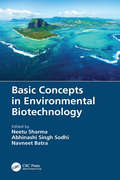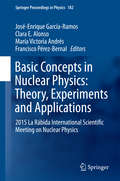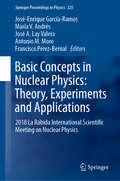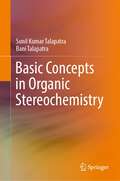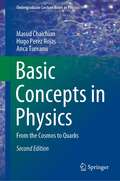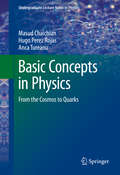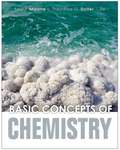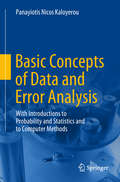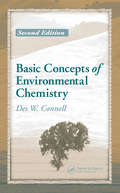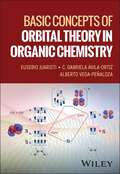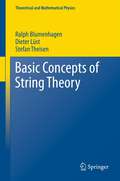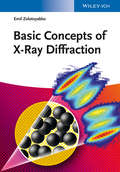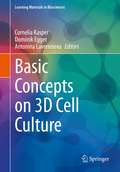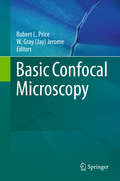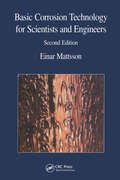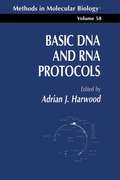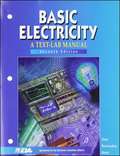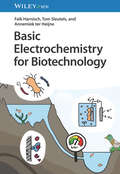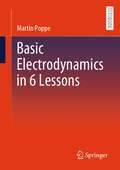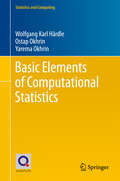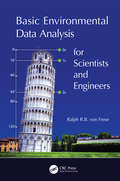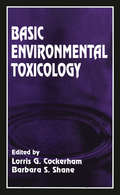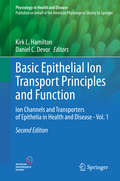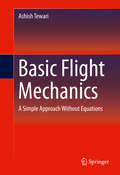- Table View
- List View
Basic Concepts in Environmental Biotechnology
by Neetu Sharma Abhinashi Singh Sodhi Navneet BatraThe book includes current and emerging concepts in the areas of environmental biotechnology such as pollution sources, control and measurement, solid waste management, bioremediation, biofuels, biosensors, bioleaching, conservation biotechnology and more. The book also includes recent innovations made in this field and incorporates case studies to help in understanding the concepts. This book applies principles from multidisciplinary sciences of environmental engineering, metabolic engineering, rDNA technology and omics to study the role of microbes and plants in tackling environmental issues. It also includes content related to risk assessment and environmental management systems. Each chapter provides problems and solutions of different topics with diagrammatic illustrations and tables for students, researchers and other professionals in environmental biotechnology. Explores cutting-edge technologies, including nanotechnology-based bioremediation, value-added products from waste and emerging techniques related to environmental risk assessment and monitoring Reviews the current methods being applied in the environment field for pollution control, waste management, biodegradation of organic and inorganic pollutants and so on Provides in-depth knowledge of the latest advancements in the field of environmental biotechnology such as bioleaching, biomining and advances in biotechnology-based conservation of biodiversity Introduces undergraduate and post-graduate students to basic concepts of environmental biotechnology and allied fields Discusses different products such as biofuels, biopolymers and biosensors that are being produced using biotechnological methods, thus contributing towards the goal of sustainable development Dr. Neetu Sharma is Assistant Professor in the Department of Biotechnology, GGDSD College, Chandigarh, India. The main thrust of her research centers on biotechnology, bioremediation and nanotechnology. Abhinashi Singh Sodhi is Assistant Professor in the Department of Biotechnology, GGDSD College, Chandigarh, India. His current research focuses on waste reduction, valorization and bioproduct formation. Dr. Navneet Batra is Associate Professor and Head, Department of Biotechnology, GGDSD College, Chandigarh, India. He has extensive academic and research experience of over 20 years with specialization in biotechnology and biochemical engineering.
Basic Concepts in Nuclear Physics: 2015 La Rábida International Scientific Meeting on Nuclear Physics (Springer Proceedings in Physics #182)
by José-Enrique García-Ramos Clara E. Alonso María Victoria Andrés Francisco Pérez-BernalThis volume covers invited papers presented during the La Rábida 2015 International Scientific Meeting on Nuclear Physics, which can be considered heir of a well known series of triennial international summer schools on Nuclear Physics organized from 1982 till 2003 by the Basic Nuclear Physics group in the University of Sevilla. The La Rábida 2015 meeting offered to graduate students and young researchers a broad view of the field of Nuclear Physics. The first invited speaker presented the state-of-the-art of Relativistic Mean Field calculations. The second set of notes covers selected topics in gamma ray spectroscopy with exotic nuclei. The third speaker presented an introduction to the subject of severe accidents in nuclear power plants. In the fourth set of notes, the author illustrated how to use laser spectroscopy to determine very important observables of atomic nuclei. The fifth speaker devoted its notes to explain several aspects of neutrino physics. Finally, the sixth speaker presented an overview of nuclear medicine and radiodiagnostic. In addition to this, the inclusion of the posters and seminars presented by the students gives a fresh and ample perspective on the many different problems of interest nowadays for the Nuclear Physics community.
Basic Concepts in Nuclear Physics: 2018 La Rábida International Scientific Meeting on Nuclear Physics (Springer Proceedings in Physics #225)
by José-Enrique García-Ramos Francisco Pérez-Bernal María V. Andrés José A. Lay Valera Antonio M. MoroThis book features material presented at the La Rábida 2018 International Scientific Meeting on Nuclear Physics, which was based on a well-known series of triennial international summer schools on Nuclear Physics organized from 1982 to 2003 by the Basic Nuclear Physics group at the University of Seville and latter, from 2009 to 2018, by the University of Seville and the University of Huelva. The meeting offered graduate students and young researchers a broad overview of the field of nuclear physics.The book includes contributions from invited speakers on topics such as a state-of-the-art nuclear shell model and selected aspects of mass spectroscopy. Other chapters present an introduction to shell model, a review of experimental nuclear reactions, a discussion of the theory of nuclear reactions and an overview of nuclear medicine. Further, the posters and seminars presented by students offer fresh perspectives on various problems current in nuclear physics.
Basic Concepts in Organic Stereochemistry
by Sunil Kumar Talapatra Bani TalapatraThis book discusses essential stereochemical concepts associated with organic molecules (natural or synthetic), as reflected in the course of their many reactions, their mechanisms, their asymmetric synthesis, biosynthesis, and biological activities. This treatise provides useful insights and understanding of the chiral/achiral designations (nomenclatures), the stereochemical features, and related properties of the natural and synthetic products. Without having an adequate knowledge of stereochemical concepts, it will not be possible to understand and appreciate the stereochemistry of natural or synthetic products. Thus, essential static and dynamic aspects of stereochemistry with sufficient illustrative examples along with discussions are presented. The structure of the monograph allows for easy selection of separate topics for reading and teaching. This book will also provide an idea of basic stereochemical concepts, as applied to organic molecules in general as well as to organic ligands in coordination complexes, and will, therefore, be valuable resources to teachers and students of advanced undergraduates and post-graduates, researchers, and professionals.
Basic Concepts in Physics: From the Cosmos to Quarks (Undergraduate Lecture Notes in Physics)
by Masud Chaichian Anca Tureanu Hugo Perez RojasThis book is the second edition of an excellent undergraduate-level overview of classical and modern physics, intended for students of physics and related subjects, and also perfectly suited for the education of physics teachers. The twelve-chapter book begins with Newton’s laws of motion and subsequently covers topics such as thermodynamics and statistical physics, electrodynamics, special and general relativity, quantum mechanics and cosmology , the standard model and quantum chromodynamics. The writing is lucid, and the theoretical discussions are easy to follow for anyone comfortable with standard mathematics.An important addition in this second edition is a set of exercises and problems, distributed throughout the book. Some of the problems aim to complement the text, others to provide readers with additional useful tools for tackling new or more advanced topics. Furthermore, new topics have been added in several chapters; for example, the discovery of extra-solar planets from the wobble of their mother stars, a discussion of the Landauer principle relating information erasure to an increase of entropy, quantum logic, first order quantum corrections to the ideal gas equation of state due to the Fermi-Dirac and Bose-Einstein statistics. Both gravitational lensing and the time-correction in geo-positioning satellites are explained as theoretical applications of special and general relativity. The discovery of gravitational waves, one of the most important achievements of physical sciences, is presented as well. Professional scientists, teachers, and researchers will also want to have this book on their bookshelves, as it provides an excellent refresher on a wide range of topics and serves as an ideal starting point for expanding one’s knowledge of new or unfamiliar fields. Readers of this book will not only learn much about physics, they will also learn to love it.
Basic Concepts in Physics: From the Cosmos to Quarks (Undergraduate Lecture Notes in Physics)
by Masud Chaichian Anca Tureanu Hugo Perez Rojas"Basic Concepts in Physics: From the Cosmos to Quarks" is the outcome of the authors' long and varied teaching experience in different countries and for different audiences, and gives an accessible and eminently readable introduction to all the main ideas of modern physics. The book’s fresh approach, using a novel combination of historical and conceptual viewpoints, makes it ideal complementary reading to more standard textbooks. The first five chapters are devoted to classical physics, from planetary motion to special relativity, always keeping in mind its relevance to questions of contemporary interest. The next six chapters deal mainly with newer developments in physics, from quantum theory and general relativity to grand unified theories, and the book concludes by discussing the role of physics in living systems. A basic grounding in mathematics is required of the reader, but technicalities are avoided as far as possible; thus complex calculations are omitted so long as the essential ideas remain clear. The book is addressed to undergraduate and graduate students in physics and will also be appreciated by many professional physicists. It will likewise be of interest to students, researchers and teachers of other natural sciences, as well as to engineers, high-school teachers and the curious general reader, who will come to understand what physics is about and how it describes the different phenomena of Nature. Not only will readers of this book learn much about physics, they will also learn to love it.
Basic Concepts of Chemistry (Ninth Edition)
by Leo J. Malone Theodore DolterThe 9th edition of Malone's Basic Concepts of Chemistry provides many new and advanced features that continue to address general chemistry topics with an emphasis on outcomes assessment. New and advanced features include an objectives grid at the end of each chapter which ties the objectives to examples within the sections, assessment exercises at the end each section, and relevant chapter problems at the end of each chapter. Within WileyPLUS, content is organized into "concept modules" that contain clear learning objectives from the text; examples, to help "show" how to do things; and automatically graded practice problems embedded in the content, to test knowledge. A new Math Check allows quick access to the needed basic skill. The first chapter now includes brief introductions to several fundamental chemical concepts and Chapter Synthesis Problems have been added to the end of each chapter to bring key concepts into one encompassing problem. Every concept in the text is clearly illustrated with one or more step by step examples. Making it Real essays have been updated to present timely and engaging real-world applications, emphasizing the relevance of the material they are learning. This edition continues the end of chapter Student Workshop activities to cater to the many different learning styles and to engage users in the practical aspect of the material discussed in the chapter.
Basic Concepts of Data and Error Analysis: With Introductions to Probability and Statistics and to Computer Methods
by Panayiotis Nicos KaloyerouThis introductory textbook explains the concepts and methods of data and error analysis needed for laboratory experiment write-ups, especially physics and engineering experiments. The book contains the material needed for beginning students, e.g., first year university students, college students (enrolled on a certificate or diploma course) and even A-level students. Nevertheless, it also covers the required material for higher year university laboratories, including the final year. Only essential concepts and methods needed for the day-to-day performance of experiments and their subsequent analysis and presentation are included and, at the same time, presented as simply as possible. Non-essential detail is avoided. Chapter five is a stand-alone introduction to probability and statistics aimed at providing a theoretical background to the data and error analysis chapters one to four. Computer methods are introduced in Chapter six. The author hopes this book will serve as a constant reference.
Basic Concepts of Environmental Chemistry
by Des W. ConnellBasic Concepts of Environmental Chemistry, Second Edition provides a theoretical basis for the behavior and biological effects of natural chemical entities and contaminants in natural systems, concluding with a practical focus on risk assessment and the environmental management of chemicals. The text uses molecular properties such as pola
Basic Concepts of Orbital Theory in Organic Chemistry
by Eusebio Juaristi C. Gabriela Avila-Ortiz Alberto Vega-PenalozaIncrease your understanding of molecular properties and reactions with this accessible textbook The study of organic chemistry hinges on an understanding and capacity to predict molecular properties and reactions. Molecular Orbital Theory is a model grounded in quantum mechanics deployed by chemists to describe electron organization within a chemical structure. It unlocks some of the most prevalent reactions in organic chemistry. Basic Concepts of Orbital Theory in Organic Chemistry provides a concise, accessible overview of this theory and its applications. Beginning with fundamental concepts such as the shape and relative energy of atomic orbitals, it proceeds to describe the way these orbitals combine to form molecular orbitals, with important ramifications for molecular properties. The result is a work which helps students and readers move beyond localized bonding models and achieve a greater understanding of organic chemical interactions. In Basic Concepts of Orbital Theory in Organic Chemistry readers will also find: Comprehensive explorations of stereoelectronic interactions and sigmatropic, cheletropic, and electrocyclic reactions,Detailed discussions of hybrid orbitals, bond formation in atomic orbitals, the Hückel Molecular Orbital Method, and the conservation of molecular orbital symmetrySample exercises for organic chemistry students to help reinforce and retain essential concepts Basic Concepts of Orbital Theory in Organic Chemistry is ideal for advanced undergraduate and graduate students in chemistry, particularly organic chemistry.
Basic Concepts of String Theory (Theoretical and Mathematical Physics)
by Dieter Lüst Ralph Blumenhagen Stefan TheisenThe purpose of this book is to thoroughly prepare the reader for research in string theory at an intermediate level. As such it is not a compendium of results but intended as textbook in the sense that most of the material is organized in a pedagogical and self-contained fashion. Beyond the basics, a number of more advanced topics are introduced, such as conformal field theory, superstrings and string dualities - the text does not cover applications to black hole physics and cosmology, nor strings theory at finite temperatures. End-of-chapter references have been added to guide the reader wishing to pursue further studies or to start research in well-defined topics covered by this book.
Basic Concepts of X-Ray Diffraction
by Emil ZolotoyabkoAuthored by a university professor deeply involved in X-ray diffraction-related research, this textbook is based on his lectures given during more than 20 years for graduate students. It adopts a well-balanced approach, describing basic concepts and experimental techniques, which make X-ray diffraction an unsurpassed method for studying the structure of materials.Both dynamical and kinematic X-ray diffraction is considered from a unified viewpoint, in which the dynamical diffraction in single-scattering approximation serves as a bridge between these two parts. The text emphasizes the fundamental laws that govern the interaction of X-rays with matter, but also covers in detail classical and modern applications, e.g., line broadening, texture and strain/stress analyses, X-ray mapping in reciprocal space, high-resolution X-ray diffraction in the spatial and wave vector domains, X-ray focusing, inelastic and time-resolved X-ray scattering. This unique scope, in combination with otherwise hard-to-find information on analytic expressions for simulating X-ray diffraction profiles in thin-film heterostructures, X-ray interaction with phonons, coherent scattering of Mössbauer radiation, and energy-variable X-ray diffraction, makes the book indispensable for any serious user of X-ray diffraction techniques.Compact and self-contained, this textbook is suitable for students taking X-ray diffraction courses towards specialization in materials science, physics, chemistry, or biology. Numerous clear-cut illustrations, an easy-to-read style of writing, as well as rather short, easily digestible chapters all facilitate comprehension.
Basic Concepts on 3D Cell Culture (Learning Materials in Biosciences)
by Cornelia Kasper Antonina Lavrentieva Dominik EggerThis textbook shall introduce the students to 3D cell culture approaches and applications. An overview on existing techniques and equipment is provided and insight into various aspects and challenges that researchers need to consider and face during culture of 3D cells is given. The reader will learn the importance of physiological cell, tissue and organ models and gains important knowledge on 3D analytics. This textbook deepens selected aspects of the textbook “Cell Culture Technology”, which also is published in this series, while offering extended insight into 3D cell culture. The concept of the textbook encompasses various lectures ranging from basics in cell cultivation, tissue engineering, biomaterials and biocompatibility, in vitro test systems and regenerative medicine. The textbook addresses Master- and PhD students interested and/or working in the field of modern cell culture applications and will support the understanding of the essential strategies in 3D cell culture and waken awareness for the potentials and challenges of this application.
Basic Confocal Microscopy
by Robert L. Price W. Gray JeromeMost researchers agree that biological confocal microscopy was jump-started by the confocal design first published by White and Amos in 1985 in the Journal of Cell Biology. As a result, this remains a relatively young field. Yet the use of the technique has grown phenomenally since those early efforts, with new users joining the ranks daily. The publication of Basic Confocal Microscopy reflects the burgeoning need to train new students, technologists, and faculty wishing to use confocal microscopy in their research. A direct outgrowth of the authors' five-day intensive course in the subject begun in 2005, this book covers the basics and includes all the information required to design, implement, and interpret the results of, biological experiments based on confocal microscopy. Concise yet comprehensive, the volume begins by covering the core issues of fluorescence, specimen preparation and labeling, before moving on to address the analog-to-digital conversion of specimen data gathered using confocal microscopy. Subsequent chapters detail the practicalities of operating confocal microscopes, providing all the information necessary to begin practicing confocal microscopy as well as optimizing the material obtained. The final block of chapters examine 3-dimensional analysis and the reconstruction of data sets, outline some of the ethical considerations in confocal imaging, and then supply a number of resources that the authors have found useful in their own work. Once readers have mastered the information this book presents, the resources found in its pages will be an excellent guide to continued learning about the more advanced forms of confocal microscopy.
Basic Confocal Microscopy
by Robert L. Price W. Gray JeromeBasic Confocal Microscopy, Second Edition builds on the successful first edition by keeping the same format and reflecting relevant changes and recent developments in this still-burgeoning field. This format is based on the Confocal Microscopy Workshop that has been taught by several of the authors for nearly 20 years and remains a popular workshop for gaining basic skills in confocal microscopy. While much of the information concerning fluorescence and confocal microscopy that made the first edition a success has not changed in the six years since the book was first published, confocal imaging is an evolving field and recent advances in detector technology, operating software, tissue preparation and clearing, image analysis, and more have been updated to reflect this. Several of these advances are now considered routine in many laboratories, and others such as super resolution techniques built on confocal technology are becoming widely available.
Basic Corrosion Technology for Scientists and Engineers
by Einar MattssonAn introductory guide covering Basic Corrosion Technology for Scientists and Engineers first published in 1999.
Basic DNA and RNA Protocols (Methods in Molecular Biology #58)
by Adrian J. HarwoodAn essential core collection of the latest molecular and genetic techniques for cloning, subcloning, sequencing, PCR, protein expression, and much more. Each protocol represents a time-tested, step-by-step recipe that creates an understanding of the procedure, easily reproducible results, and confidence that the procedure will work. The collection includes not only many updated and improved classic techniques, but also a powerful group of advanced methods that point to future progress, among them nonisotopic DNA labeling, silver staining, and automatic sequencing. This excellent bench companion will help those who need to learn for the first time how to conduct research on the molecular biology of nucleic acids or those who need to broaden their competence and laboratory skills. Even highly skilled researchers will find many time-saving techniques.
Basic Electricity: A Text-Lab Manual (Seventh Edition)
by Paul B. Zbar Gordon Rockmaker David J. BatesDesigned for use in traditional DC/AC courses, this text serves equally well as a stand-alone introductory text and lab manual or as a lab manual for use with any basic theory text. The content of this text/lab manual is prepared with the technical assistance of the Electronic Industries Association, guaranteeing that the material is consistent with the competencies of the electronics manufacturing and service industries.
Basic Electrochemistry for Biotechnology
by Falk Harnisch Tom Sleutels Annemiek ter HeijneBasic Electrochemistry for Biotechnology Understand the basics of a thriving interdisciplinary research field Microbial electrochemistry is a subfield of bioelectrochemistry which concerns interactions between microbial organisms and electrically active surfaces such as electrodes. Its growth as a subject of research has been rapid in recent years, and its technological applications are many, particularly as the race to find sustainable organic energy sources accelerates. Basic Electrochemistry for Biotechnology offers an accessible overview of this interdisciplinary subject and its potential applications. Moving smoothly from the general to the specific, it offers both fundamental principles and some of the most relevant specific examples, such as biofilm electrodes, microbial fuel cells or microbial electrosynthesis cells, making it the ideal choice for building a working knowledge of this exciting new field. Its solid foundation of microbial electrochemical technologies also serves as a starting point for a wide range of applied research areas. Basic Electrochemistry for Biotechnology readers will also find: Carefully designed artistic illustrations Hands-on exercises throughout to facilitate entry into laboratory work Numerous illustrative examples and calculations designed to demonstrate and reinforce key principles Basic Electrochemistry for Biotechnology is the perfect point of entry into this growing field for both students and researchers.
Basic Electrodynamics in 6 Lessons
by Martin PoppeThis book explains why there are different variants of Maxwell's equations and the physical meaning of the quantities they contain. It also shows how the equations for static electric and magnetic potentials are derived from Maxwell's equations. Matter exposed to the field is an integral part of the discussion. Multipole developments are justified and derived. Furthermore, the potential for simplification in formulating dynamical theory as gauge field theory is explained. The laws of optics are derived from those of electrodynamics. Justifications are provided for quasi-stationary calculations, limits are formulated, and technical counterexamples are shown.
Basic Elements of Computational Statistics (Statistics and Computing)
by Wolfgang Karl Härdle Ostap Okhrin Yarema OkhrinThis textbook on computational statistics presents tools and concepts of univariate and multivariate statistical data analysis with a strong focus on applications and implementations in the statistical software R. It covers mathematical, statistical as well as programming problems in computational statistics and contains a wide variety of practical examples. In addition to the numerous R sniplets presented in the text, all computer programs (quantlets) and data sets to the book are available on GitHub and referred to in the book. This enables the reader to fully reproduce as well as modify and adjust all examples to their needs. The book is intended for advanced undergraduate and first-year graduate students as well as for data analysts new to the job who would like a tour of the various statistical tools in a data analysis workshop. The experienced reader with a good knowledge of statistics and programming might skip some sections on univariate models and enjoy the various ma thematical roots of multivariate techniques. The Quantlet platform quantlet. de, quantlet. com, quantlet. org is an integrated QuantNet environment consisting of different types of statistics-related documents and program codes. Its goal is to promote reproducibility and offer a platform for sharing validated knowledge native to the social web. QuantNet and the corresponding Data-Driven Documents-based visualization allows readers to reproduce the tables, pictures and calculations inside this Springer book.
Basic Environmental Data Analysis for Scientists and Engineers
by Ralph R.B. Von FreseClassroom tested and the result of over 30 years of teaching and research, this textbook is an invaluable tool for undergraduate and graduate data analysis courses in environmental sciences and engineering. It is also a useful reference on modern digital data analysis for the extensive and growing community of Earth scientists and engineers. Basic Environmental Data Analysis for Scientists and Engineers introduces practical concepts of modern digital data analysis and graphics, including numerical/graphical calculus, measurement units and dimensional analysis, error propagation and statistics, and least squares data modeling. It emphasizes array-based or matrix inversion and spectral analysis using the fast Fourier transform (FFT) that dominates modern data analysis. Divided into two parts, this comprehensive hands-on textbook is excellent for exploring data analysis principles and practice using MATLAB®, Mathematica, Mathcad, and other modern equation solving software. Part I, for beginning undergraduate students, introduces the basic approaches for quantifying data variations in terms of environmental parameters. These approaches emphasize uses of the data array or matrix, which is the fundamental data and mathematical processing format of modern electronic computing. Part II, for advanced undergraduate and beginning graduate students, extends the inverse problem to least squares solutions involving more than two unknowns. Features: Offers a uniquely practical guide for making students proficient in modern electronic data analysis and graphics Includes topics that are not explained in any existing textbook on environmental data analysis Data analysis topics are very well organized into a two-semester course that meets general education curriculum requirements in science and engineering Facilitates learning by beginning each chapter with an ‘Overview’ section highlighting the topics covered, and ending it with a ‘Key Concepts’ section summarizing the main technical details that the reader should have acquired Indexes many numerical examples for ready access in the classroom or other venues serviced by electronic equation solvers like MATLAB®, Mathematica, Mathcad, etc. Offers supplemental exercises and materials to enhance understanding the principles and practice of modern data analysis
Basic Environmental Toxicology
by Lorris G. Cockerham Barbara S. ShaneBasic Environmental Toxicology provides a thorough, systematic introduction to environmental toxicology and addresses many of the effects of pollutants on humans, animals, and the environment. Readers are introduced to the fundamentals of toxicology and ecotoxicology, the effects of different types of toxicants, and how toxicants affect different compartments of the environment. Fundamental aspects of environmental health, occupational health, detection of pollutants, and risk assessment are discussed. The book is excellent for anyone involved in risk assessment or risk management, toxicologists, state and local public health officials, environmental engineers, industrial managers, consultants, and students taking environmental toxicology courses.
Basic Epithelial Ion Transport Principles and Function: Ion Channels and Transporters of Epithelia in Health and Disease - Vol. 1 (Physiology in Health and Disease)
by Kirk L. Hamilton Daniel C. DevorThis book discusses unique ion channels and transporters that are located within epithelial tissues of various organs including the kidney, intestine, pancreas and respiratory tract. As the authors show, these channels and transporters play crucial roles in transepithelial ion and fluid transport across epithelia and their contribution to maintaining homeostasis. Readers will be introduced to the fundamentals of ion transport in terms of function, modelling, regulation, structure and pharmacology. This is the first of three volumes highlighting the importance of epithelial ion channels and transporters in basic physiology and pathophysiology of human diseases. This volume focuses on basic fundamentals of epithelial transport physiology. There is a range of chapters dedicated to specific aspects of epithelial ion transport and cell function. Accordingly, the authors discuss techniques used to determine epithelial function, principles of epithelia transport, polarization of epithelial cells, mathematical modelling of epithelial ion transport, protein folding of ion channels, degradation epithelial ion channels, fundamentals of epithelial sodium, potassium and chloride transport, fundamentals of bicarbonate secretion, volume regulation, and microRNA regulation of epithelial channels and transporters. Given its scope, Volume 1 offers a valuable resource for physiology students, scientists and clinicians alike.
Basic Flight Mechanics: A Simple Approach Without Equations
by Ashish TewariThis book presents flight mechanics of aircraft, spacecraft, and rockets to technical and non-technical readers in simple terms and based purely on physical principles. Adapting an accessible and lucid writing style, the book retains the scientific authority and conceptual substance of an engineering textbook without requiring a background in physics or engineering mathematics. Professor Tewari explains relevant physical principles of flight by straightforward examples and meticulous diagrams and figures. Important aspects of both atmospheric and space flight mechanics are covered, including performance, stability and control, aeroelasticity, orbital mechanics, and altitude control. The book describes airplanes, gliders, rotary wing and flapping wing flight vehicles, rockets, and spacecraft and visualizes the essential principles using detailed illustration. It is an ideal resource for managers and technicians in the aerospace industry without engineering degrees, pilots, and anyone interested in the mechanics of flight.
